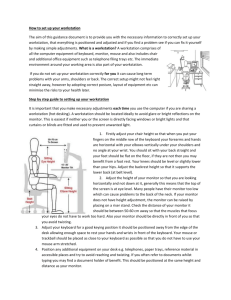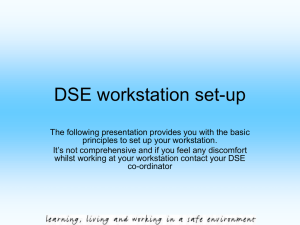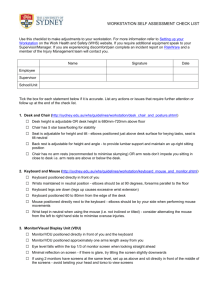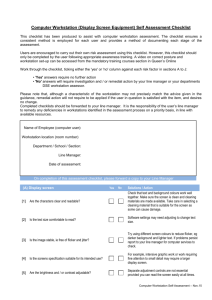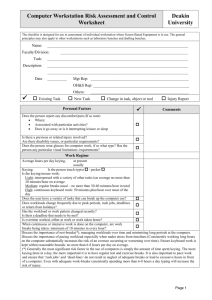Workstation self assessment for remote working
advertisement
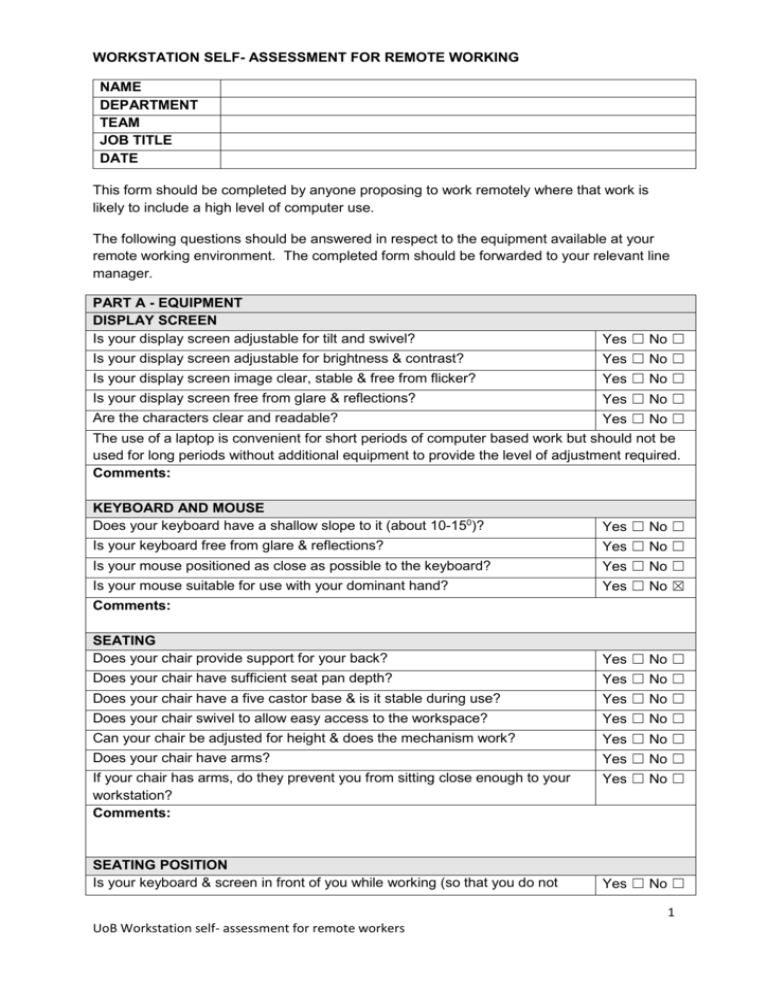
WORKSTATION SELF- ASSESSMENT FOR REMOTE WORKING NAME DEPARTMENT TEAM JOB TITLE DATE This form should be completed by anyone proposing to work remotely where that work is likely to include a high level of computer use. The following questions should be answered in respect to the equipment available at your remote working environment. The completed form should be forwarded to your relevant line manager. PART A - EQUIPMENT DISPLAY SCREEN Is your display screen adjustable for tilt and swivel? Yes ☐ No ☐ Is your display screen adjustable for brightness & contrast? Yes ☐ No ☐ Is your display screen image clear, stable & free from flicker? Yes ☐ No ☐ Is your display screen free from glare & reflections? Yes ☐ No ☐ Yes ☐ No ☐ The use of a laptop is convenient for short periods of computer based work but should not be used for long periods without additional equipment to provide the level of adjustment required. Comments: Are the characters clear and readable? KEYBOARD AND MOUSE Does your keyboard have a shallow slope to it (about 10-150)? Yes ☐ No ☐ Is your keyboard free from glare & reflections? Yes ☐ No ☐ Is your mouse positioned as close as possible to the keyboard? Yes ☐ No ☐ Is your mouse suitable for use with your dominant hand? Yes ☐ No ☒ Comments: SEATING Does your chair provide support for your back? Yes ☐ No ☐ Does your chair have sufficient seat pan depth? Yes ☐ No ☐ Does your chair have a five castor base & is it stable during use? Yes ☐ No ☐ Does your chair swivel to allow easy access to the workspace? Yes ☐ No ☐ Can your chair be adjusted for height & does the mechanism work? Yes ☐ No ☐ Does your chair have arms? Yes ☐ No ☐ If your chair has arms, do they prevent you from sitting close enough to your workstation? Comments: Yes ☐ No ☐ SEATING POSITION Is your keyboard & screen in front of you while working (so that you do not Yes ☐ No ☐ 1 UoB Workstation self- assessment for remote workers have to twist your neck and back)? When seated are your forearms parallel to the desktop & your elbows level with the middle row of keys? When looking at your screen are you looking slightly downwards (about 10200), so that you do not strain your neck muscles)? Is there sufficient space to stretch your legs while seated? Yes ☐ No ☐ Yes ☐ No ☐ Yes ☐ No ☐ Can you place your feet flat on the floor while working? Yes ☐ No ☐ If you cannot place your feet flat on the floor while working, have you got access to an adjustable footrest? Comments: Yes ☐ No ☐ DESK Is your desk free from glare & reflections & stable during use? Yes ☐ No ☐ Is there sufficient clearance on the underside of your desk for comfort? Yes ☐ No ☐ Is the height of your desk sufficient for comfort? Yes ☐ No ☐ Is your desk deep enough & wide enough for the work that you do? Yes ☐ No ☐ Is there sufficient space in front of your keyboard to support your wrists & forearms (about 100 mm)? Comments: Yes ☐ No ☐ WORKING PRACTICES Do you have periodic changes of activity away from the display screen (10 minutes in each hour)? Comments: Yes ☐ No ☐ SOFTWARE Is your computer & software sufficient for the tasks you undertake? Yes ☐ No ☐ Have you been given suitable training for the software that you use? Yes ☐ No ☐ Comments: PART B - RISK Are you free from aches and pains associated with workstation use? If no, please give brief details below. Comments: Do you have the same level of support in terms of specialist equipment (e.g. orthopaedic chair, vertical mouse) in your remote place of work as you do at your permanent place of work? If no, please provide details below Comments: Yes ☐ No ☐ Yes ☐ No ☐ 2 UoB Workstation self- assessment for remote workers Using the table below, what is the severity of your existing workstation related aches and pains ☐None ☐Trivial ☐Minor ☐Moderate ☐Serious ☐Disabled Using the table below, what is the likelihood of occurrence frequency ☐Remote ☐Unlikely ☐Possible ☐Likely ☐Very likely Multiply the number for severity by the number for likelihood. What is your total number Hazard Severity (a) Likelihood of Occurrence (b) 1 – Trivial (discomfort) 2 – Minor (slight aches and pains (temporary)) 3 – Moderate (aches and pains affecting performance but can be relieved with treatment or change in activity) 4 – Serious (persistent RSI, pain or discomfort seriously affecting performance) 5 – Disabled (inability to carry out work activities without specialist equipment) 1 – Remote (almost never) 2 – Unlikely (occurs rarely) 3 – Possible (occurs occasionally) 4 – Likely (recurrent but not permanent) 5 – Very likely (occurs frequently and persistently) Green – low risk. No further action required – suitable to work remotely 1 2 3 4 5 Orange – medium risk. Is suitable to work remotely providing answers to part A are all positive. 2 4 6 8 10 3 6 9 12 15 4 8 12 16 20 5 10 15 20 25 Red – high risk. Probably not suitable to work remotely unless evidence available (e.g. photo) to demonstrate specialist equipment is in place. Further advice can be sought from the University’s Health, Safety & Environment Service. 3 UoB Workstation self- assessment for remote workers Remote workers: Upon completion this form should be signed and sent to your line manager. Line managers: You should satisfy yourself that the information provided on this form is such that you believe the person concerned is suitable to work remotely Signed by remote worker Signed by line manager 4 UoB Workstation self- assessment for remote workers
